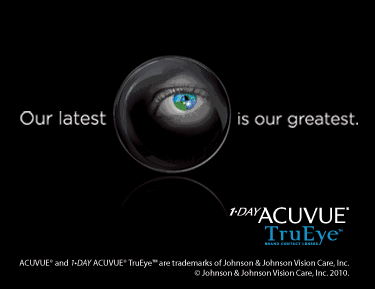|
Menicon Expands Partnership with Optimed in North America
Menicon Co., Ltd., announced its agreement with Optimed Ltd. to become the exclusive distributor for Optimed's CAPTIV8 communication services and i-Vue content-driven digital signage software for North America. Earlier this year, Menicon obtained exclusive distribution rights for Optimed's products in Japan and Taiwan.
CAPTIV8 is Web-based 3D animation software that an eyecare practitioner can use chair-side to enhance communication with patients. The technology further enables patients to view the content on their computers and mobile devices and share it with family and friends.
i-Vue is a digital display system, normally located in the practice waiting room, that uses 3D animation to educate and inform patients about products and services. i-Vue allows users to easily and quickly modify playback content from any remote location, useful for multiple location practices.
| -- ADVERTISEMENT -- |

|
AOS Announces New Award for Students
The American Optometric Society (AOS) announced an annual award in honor of Dr. Harvey Yamamoto. The monetary award of $1,000 will be given to a senior optometric student from a school or college of optometry in the United States and its territories at the AOS Annual Meeting and Continuing Education Seminar to be held in Tampa, Florida, April 1-3, 2011.
Recognizing Dr. Yamamoto's lifetime of contributions to the profession and his community, the award is based on an original essay of not more than 1,500 words highlighting how the individual plans to give back to the profession of optometry as well as the community after graduation.
The recipient will receive transportation to attend the AOS Meeting, hotel room, a year's paid membership in the American Optometric Society, and a certificate, in addition to the $1000 cash award. All entries must be submitted by Feb. 1, 2011 and the decision of the judges is final. Full details on the award and how to submit entries are available on the student link found on the AOS website at www.optometricsociety.org.
AOA Seeks Nominees for Paraoptometric Award
The American Optometric Association's (AOA) Paraoptometric Section is seeking nominations for the Paraoptometric of the Year Award (POY).
The award is given annually to the optometric assistant or technician who has made outstanding contributions to the profession of optometry, paraoptometry, and the public. The nominee's accomplishments are reviewed in the following categories: service to optometry and paraoptometric associations; participation in public service activities; personal endorsement by the nominating individual.
Nominations must be received by AOA on or prior to Feb. 1, 2011. The 2011 award for the 2011 winner will be presented on June 16, 2011 during Optometry's Meeting in Salt Lake City, Utah. The winner will be featured in a video and will receive a plaque, round-trip airfare to Optometry's Meeting, three nights' lodging at the headquarters hotel, and $500 to help defray the travel expenses.
The award has been funded courtesy of Ciba Vision. For a nomination form or more information, contact the AOA Paraoptometric Section at 800-365-2219, ext. 4108 or e-mail JMAprahamian@aoa.org.
Allergan Introduces Online Tool
Allergan announced a new digital tool designed to help practitioners quickly and easily determine patient co-pays when prescribing Restasis. The online Restasis Co-pay Lookup tool allows practitioners to enter a patient's ZIP code and immediately obtain the average co-pay for the top managed care providers in the area.
The tool is designed to help improve the dialogue between practitioners and patients around dry eye management, which may include Restasis. The co-pay tool enables practitioners to provide more specific, on-the-spot estimates of the expected co-pay based on plan and geographic area. The online tool is optimized for smart phone access, providing the added flexibility of accessing the tool away from the computer. The feature is available online at www.RESTASIScopay.com.
Global Specialty Lens Symposium, January 27-30, 2011, Paris Hotel & Casino in Las Vegas

Plan now to attend the Global Specialty Lens Symposium in January 2011. With an expert international faculty and a CE-accredited agenda, the 2011 GSLS will include insightful presentations by experts in the field, hands-on demonstrations of cutting-edge products as well as scientific papers and posters. Look for more detailed information in future issues of Contact Lens Spectrum and online at www.GSLSymposium.com.
--ADVERTISING
Dry Eye Treatment Focus of Agreement
Resolvyx Pharmaceuticals Inc., a developer of anti-inflammatory drugs, and Celtic Pharma have entered into an agreement relating to Resolvyx's dry-eye syndrome treatment. The deal gives Celtic Pharma an exclusive option to acquire and license rights to RX-10045, the late-stage treatment for dry eye syndrome developed by Resolvyx. Celtic Pharma also has the option to license rights to another eye treatment. No financial details of the agreement were disclosed.
Resolvyx's RX-10045, which won a United States patent in 2009, is set to begin a Phase 3 study next year. The treatment is given in the form of eye drops, made of a resolvin, which is designed to have a potent effect on such diseases as rheumatoid arthritis, asthma, inflammatory bowel disease, dry eye and retinal disease.
Ocusoft Recognized for Work Environment
Ocusoft, Inc. was named one of the Top Workplaces by the Houston Chronicle. The Top 100 Workplaces recognizes businesses in the Houston area nominated by their own employees and based on employee opinions about company leadership, compensation and training, career development, family friendly flexibility, and values and ethics. Private, nonprofits and publicly-held businesses were included in the analysis.
The rankings in Top Workplaces are based on survey information collected by Workplace Dynamics.
This month at www.siliconehydrogels.org: the results of the 2009 International Contact Lens Prescribing Survey, the impact of UV-absorbing silicone hydrogel lenses, fitting silicone hydrogels for patients with sub-optimal endothelial cell function, and our synopsis of silicone hydrogels at the 2009 American Academy of Optometry meeting.
|












